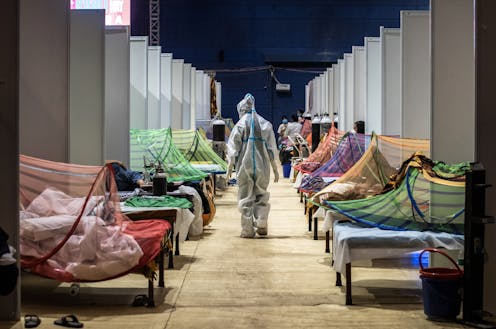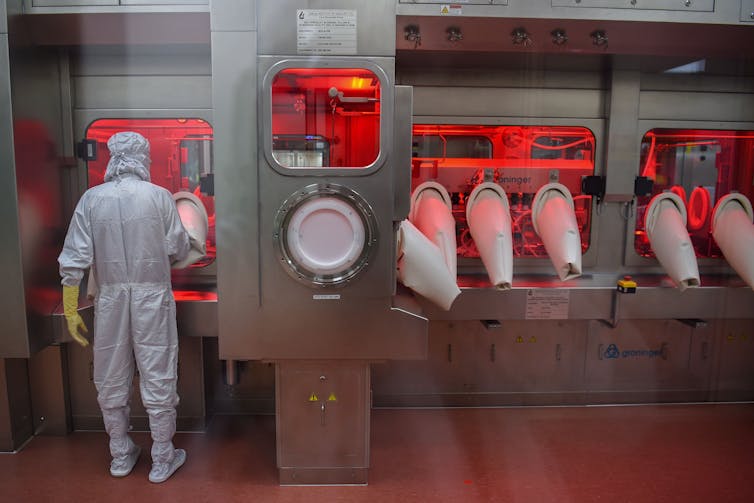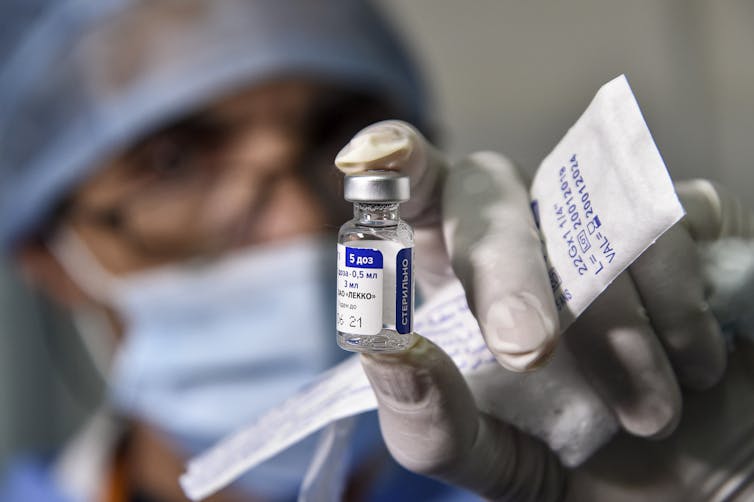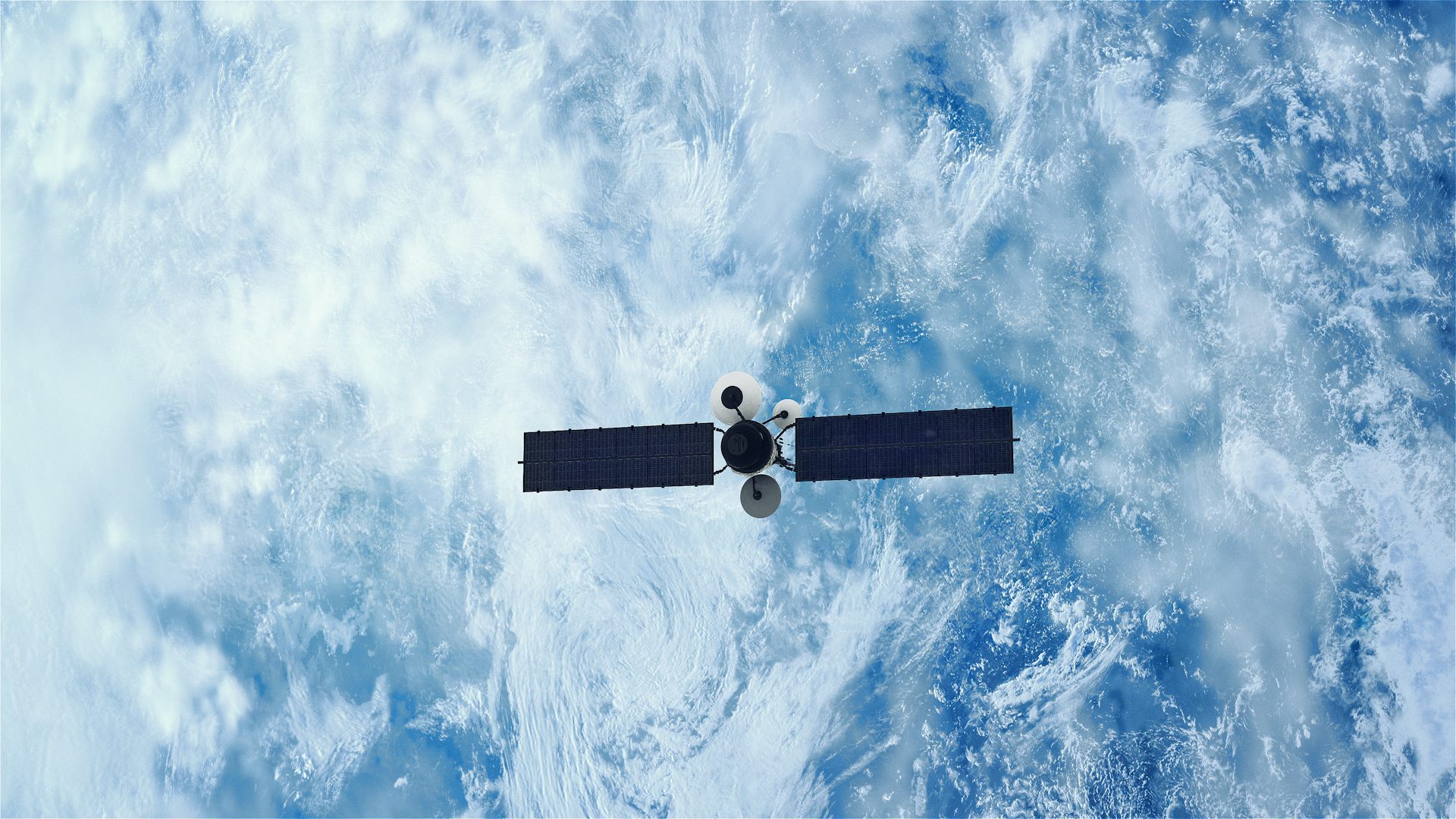US support for waiving COVID-19 vaccine patent rights puts pressure on drugmakers – but what would a
The process will take months, if it's even approved. But just the threat of waiving intellectual property rights could spur faster action.

The U.S. and Europe are debating waiving patent rights for COVID-19 vaccines, a move that could allow more companies to produce the vaccine around the world. But it’s not as simple as it might sound.
When the U.S. announced on May 5, 2021, that it supported the idea of a temporary waiver, the statement was vague. Some European countries still oppose even a narrow waiver.
Any agreement will take weeks of negotiation among the World Trade Organization’s 164 members, and then months more for production to begin.
That long timeline won’t solve the immediate problem. Many poor countries have vaccinated less than 1% of their populations, while 44% of the vaccine doses have gone to Europe and North America, where wealthy countries secured large vaccine contracts. At the same time, the disease is spreading quickly in South Asia, and new variants are raising the risks around the world.
The idea of temporarily waiving World Trade Organization rules on intellectual property rights for the COVID-19 vaccines was first proposed by South Africa and India in late 2020. The original proposal was broad, covering patents, copyrights, trade secrets and industrial designs related to the “prevention, containment or treatment of COVID-19.”
The U.S. is suggesting a much narrower approach, but exactly what that would look like isn’t yet clear.
Some European countries with vaccine industries, including Germany, argue that waiving intellectual property rights would pose a danger to future vaccine innovation and is unnecessary. Others pointed out that most countries in need lack the facilities, technology and skilled technicians to produce the vaccines even if patent rights were waived, and said the bigger problem was countries like the U.S. and Britain preventing their vaccines and ingredients from being exported to the rest of the world.
Critics are correct that, by itself, a temporary waiver is not sufficient to address the gap in production. They are correct that vaccine ingredients and other supplies remain a major blockage.
But it is also clear that vaccine makers are not voluntarily licensing their vaccines at the scale needed to expand production enough to stop the pandemic.

The UNICEF COVID Dashboard shows that Moderna and Pfizer/BioNTech, which both use new mRNA technology in their vaccines, have licensed to few other companies. Moderna had voluntarily agreed not to enforce its patents but has not shared trade secrets or know-how. Johnson & Johnson and AstraZeneca have primarily licensed to companies with which they carried out national clinical trials, and these may be limited just to production for export for existing developed country contracts or purely domestic supply. Refusals to license to experienced drug manufacturers such a Biolyse in Canada or Teva in Israel present a serious problem.
I have worked on legal issues related to access to medicines since 2004 and have been involved in these debates at the WTO and the World Intellectual Property Organization. I believe that U.S. support of the waiver proposal can lead to an effective outcome if minimum criteria are met: The vaccine makers will have to give up some control, and the countries must ensure those companies are appropriately compensated.
The waiver could build on the existing system for compulsory licensing of patents and extend that to trade secrets and knowledge. The negotiations around access to HIV/AIDS medicines in the 1990s ended up with a similar framework.
How to make compulsory licenses work for vaccines
When a country approves a patent, it gives the patent holder a monopoly for a limited term, usually 20 years, for new and highly inventive ideas. The key phrase is “limited time.” This makes sure that once a patent runs out, others can make the product. Generic drugs are an example.
For emergencies, the patent system has safety valves that allow governments to intervene before that limited time is up. Based on public needs – including health emergencies – a government can allow others to make the product, usually with a reasonable royalty, or fee, paid to the patent owner. This is known as a compulsory license.
Today, any country that has issued a patent to a COVID-19 vaccine maker can use that patent simply by issuing a compulsory license to enable production by its own companies.
The problem is that many countries don’t have vaccine production facilities within their borders – they need to rely on imports. But under Article 31 of the WTO’s Agreement on Trade-Related Aspects of Intellectual Property, or TRIPS, compulsory licenses can’t be used to produce vaccines for exporting to other countries. That means countries like China and the Philippines that have thriving pharmaceutical industries can’t use compulsory licenses to send vaccines to Africa, for example.

There have been several attempts to solve this problem, including a change to the TRIPS Agreement approved in 2005. But only one country – Rwanda – has used that system to access drugs, and it was deemed too difficult to use. Rwanda was able to import 7 million doses from Canada, but it took almost two years, and the Canadian generic producer declared the system economically unsustainable for a private company.
The technologies in COVID-19 vaccines, especially those based on mRNA vaccines, are complex and involve multiple patents, trade secrets and know-how. The TRIPS Agreement requires countries to provide protection for trade secrets. Some countries’ laws, such as the U.S. Defense Production Act, allow for requiring such technology transfer, but many countries don’t want to violate the agreement.
To successfully expand vaccine production, countries need a relatively seamless system. The waiver must lift the TRIPS limitations on exports and allow countries to require sharing of trade secrets and know-how. This would let a country like the Philippines issue a blanket license for COVID-19 technologies, allow its companies to produce vaccines developed elsewhere and export those vaccines to countries that lack their own manufacturing capacity.
Lifting those restrictions could help ensure that the world is not still in the same position in 2022. And that is what the proposal is truly aimed at.
How soon could the world see results?
Both the threat of the waiver and its actual implementation could accomplish several things.
First, they increase the incentive for companies to voluntarily license their vaccines and transfer knowledge to trusted partners in other countries. Provided there is pressure to do so, they could allow production for export to additional countries.
Second, they increase the leverage developing country companies and governments have in negotiations with vaccine makers for licenses, like the production agreement between Merck and Johnson & Johnson brokered by the Biden administration.
Finally, if implemented, the waiver would ensure that pharmaceutical companies are compensated for their work in developing vaccines while ensuring that they cannot prevent wider production.
This is an international emergency that requires “extraordinary measures,” as U.S. Trade Representative Katherine Tai noted. These measures do not need to be taken at the cost of either innovation or access.
This article updates a version published April 14, 2021.
Dalindyebo Shabalala is affiliated with the Center for International Environmental Law (CIEL) as a Board Member. He has previously worked at the South Centre, an intergovernmental organization of developing countries on Access to Medicines projects funded by the Rockefeller Foundation, SIDA, and GIZ among others
Read These Next
The North Pole keeps moving – here’s how that affects Santa’s holiday travel and yours
There are actually two North Poles. One has been wandering over northern Canada and north of there for…
2 superpowers, 1 playbook: Why Chinese and US bureaucrats think and act alike
The men and women tasked with implementing policy are governed by the same incentives and constraints…
A, B, C or D – grades might not say all that much about what students are actually learning
Grades can magnify inequities that exist in American schools, making it harder for some students to…






